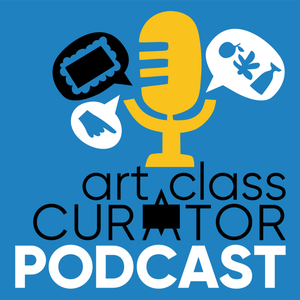
Art Class Curator
Cindy Ingram
- 32 minutes 52 secondsThe Gentle Way Back to Creating: What To Do When Everything Feels Too Much
The last couple of weeks have been intense. Between processing the presidential election results (which has left many of us feeling scared, emotional, angry, and sad) and some difficult things happening in my personal life, my creative practice has completely fallen by the wayside. That daily art practice I shared with you before? The one with the squares for each day? Gone. Those mosaics I was making tons of? Haven't touched them. I simply haven't had the energetic, emotional, or mental capacity for any of it.
Watch this episode on video: https://youtu.be/-dGpUlC6QnM?si=z9clL7Z-9eX6mFln
You know those times when the world feels like it's falling down around you, and the thought of picking up a paintbrush or sitting down to write feels completely overwhelming? That's exactly where I am right now, and I know I'm not alone. This week, I was meeting with a coaching client who's working on an exciting creative project—one that usually lights her up—and she shared that she's experiencing the same thing. The election results knocked her over too, and she hasn't been able to put any creative energy toward her work.
Here's the thing: I've noticed that when life gets intense, our creative practices are often the first things to slip away. It's totally normal. As someone who makes art, writes, and generally tries to stay creative, I've learned that there are gentle ways to keep our creativity alive even when we don't have the emotional or mental capacity for big projects.
Creating Safe Space for Creativity
Let's talk about something really important that I've learned: to be able to create, you need to feel some level of safeness. Your nervous system needs to be at least somewhat regulated. You don't need to feel 100% safe—just enough to get started.
What does that look like in practice? It's different for everyone, but here are some things that help me:
* Creating a soothing environment (yes, it sounds cliché, but lighting a candle or playing specific music really does help)
* Finding your comfort drink (I'm literally sipping iced coffee as I write this, even though it's 4 PM)
* Setting up a dedicated creative space, even if it's just a corner of your desk
* Using meditation apps (I've been trying Insight Timer lately—turns out meditation isn't so bad with my ADHD when I have something to focus on)
Starting Small (Really Small)
One of my program participants came up with this brilliant idea: she made a post-it note that said "2 minutes" and listed all the creative things she could do in that time:
* Write a haiku
* Make a quick drawing
* Take photos of interesting plants on a walk
* Doodle on a post-it
It doesn't have to be a big event. You don't need to set up cameras and art supplies and make a whole production of it (trust me, I get it—I'm literally has to make the video simpler than usual because that's what I can handle right now).
Finding Your "Just Right" Activity
For me, one of the most soothing creative practices is collecting paper scraps and gluing them down. I can watch TV or listen to an audiobook while I do it. It's engaging enough to keep my hands busy but not so demanding that it overwhelms my emotional capacity.
Your "just right" activity might be:
* Neurographic art (making lines and rounding the edges)
* Playing with watercolors and watching them flow
* Stream-of-consciousness writing
* Moving your body through dance or large gesture drawing
* Working with clay
* Following a simple art tutorial on YouTube
The key is finding something that feels luscious and good to you, without being overwhelming.
Remember: It's About the Process, Not the Product
There's this amazing Kurt Vonnegut quote where he tells students to write a poem and then tear it up—scatter the pieces in different trash cans so no one can ever put it back together. Why? Because you still grow from the act of creating, even if no one ever sees it.
I spent years not making art because I thought it had to be "good." I studied art history, I knew what "good art" looked like, and I convinced myself that if I couldn't make that, it wasn't worth making anything at all. What a waste! I've been making art for several years now, and while I haven't made any money from it, it has changed my life in profound ways.
Stay Engaged (Even Just a Little)
The longer you stay away from your creative practice, whatever it is, the harder it gets to come back to it. (And if you're neurodivergent like me, you might literally forget that you're an artist or writer—whoops!)
Staying engaged, even in tiny ways, reminds your subconscious and your nervous system: "Hey, this is still a thing I do. This is still part of who I am." It helps you hold onto that part of yourself when things get hard.
A Gentle Reminder
If you're struggling to create right now, you're not alone. Allow yourself to create without expectation, without pressure for it to look or sound any particular way. Your creativity isn't gone—it might just need a gentler approach right now.
Remember: engaging with your creativity is valuable with or without an outcome. Sometimes the most important thing is just showing up, even if all you do is tear up paper or write three lines in your journal.
What small creative act could you do today? Not to make something amazing, not to share it with anyone, just to stay connected to that part of yourself?
Get full access to Art and Self with Cindy Ingram at cindyingram.substack.com/subscribe17 November 2024, 10:41 pm - 49 minutes 38 secondsThe Truth About My Work: What We Create is Magic ✨
In this vulnerable share on my podcast and YouTube, I open up about my journey of embracing my true self through healing through art and creative community. Watch as I process these revelations through art journaling while discussing last night's powerful tarot session, the magic that happens in our art interpretation circles, and my upcoming tarot program. Join me as I reflect on self-acceptance, neurodiversity, and the healing power of creative community.
To see me making art at the same time, watch this podcast episode on YouTube:
🎨 Mentioned Programs:
* Art Church (Monthly Free Sessions) - https://cindyingram.com/art-church
* Art Connection Circle - https://cindyingram.com/circle
* New Tarot Program (Coming Soon!)
✨ Want to join our creative community?
* Subscribe to my Substack - https://cindyingram.substack.com
* Learn about Art Church - https://cindyingram.com/art-church
🖼️ Featured In Video:
* Light Seer's Tarot Deck - https://amzn.to/48ExgFb (affiliate link)
* Last Week's Video -
* More about my River Trip - https://cindyingram.substack.com/p/sunday-strokes-a-river-trip-and-a
* This is Me - Table Sing -
* This is Me - Britain's Got Talent -
Art and Self with Cindy Ingram is a reader-supported publication. To receive new posts and support my work, consider becoming a free or paid subscriber.
Get full access to Art and Self with Cindy Ingram at cindyingram.substack.com/subscribe29 October 2024, 8:29 pm - 41 minutes 12 secondsIntroducing Spacious Creative - Episode 1: Our Creative Roots
Hello! I'm excited to introduce you to the first episode of a brand new collaborative podcast with my friend Heather Doyle Fraser over on our new substack, The Spacious Creative. In this limited series podcast, we'll explore the topic of creativity from all sorts of angles. If you are a creative person or especially if you are a creative person "in hiding," I know you'll get great value from listening to our conversations on creativity. In this episode, we break down our histories of being creative, including times when we both went into hiding as creatives. We'll be releasing episodes every Thursday through the end of August! Also be sure to register for our upcoming workshop on July 24! Click here to register.
--
In Episode 1 of Spacious Creative, Cindy Ingram and Heather Doyle Fraser explore how creativity has shaped and shown up in their lives. For both, being creative isn’t something that “happened” to them; it is an identity that has been with them as far back as they can remember: early childhood. During this time, creating wasn’t hard or challenging—it was a joy and a comfort and a place of freedom.
This beginning place of ease and contentment didn’t remain static. After exploring these beginning experiences with creativity, Heather and Cindy walk us through how they navigated being creative over their lives: the natural ebbs and flows and the imposed expansions and contractions that we all experience as creatives, artists, and writers.
What we experience in our early lives is often indicative of the passions and pursuits that enthrall us as adults, though, if we can allow ourselves to follow and trust those inclinations. We all have a story of creativity and how we began our creative journey, and although Heather and Cindy’s journeys might have different details, the broad brushstrokes might bear a striking resemblance to your experiences. Here are some of the brushstrokes these two creatives explore in their conversation:
-
Early childhood creativity had a clear impact on lifelong artistic pursuits.
-
Inspiration came in many forms and there are clear and distinct childhood memories, like drawing, painting, making up stories, “writing” before you could write, and arranging spaces to feel comfortable and safe.
-
The influence of encouragement and discouragement on sharing creativity and artistic endeavors.
-
Navigating perfectionism and its effect on the creative process.
-
Using art to process emotions and experiences during adolescence
-
Personal stories and reflections on the role of creativity in self-expression and growth.
-
We sometimes stop creating for ourselves when our society deems it impractical, but we can come back to these endeavors over time when we begin to trust ourselves and our creativity again.
To register for our workshop on July 24, Trust Your Why: Your Creative Comfort Zone Needs You, click this link!
Click here to subscribe to our substack!
Get full access to Art and Self with Cindy Ingram at cindyingram.substack.com/subscribe11 July 2024, 3:15 pm -
- 1 hour 4 minuteson coping, compassion, and accommodation with Melissa Cox
In this engaging podcast episode, Melissa Cox joins me to discuss the artwork Coping by Nicole Eisenman.
Here's a bulleted list of what we discussed in this episode, thanks to our friend Chat GPT.
- The feeling of being worn down by internal struggles or long-term challenges
- Reflections on hope and despair, and the isolation it can bring
- The importance of representation and seeing possibilities for different choices
- Personal anecdotes illustrating the impact of representation on decision-making
- Discovering one's neurodiversity and the journey of self-acceptance and accommodation
- The need for radical acceptance and compassion for oneself and others
- Coping mechanisms and harm reduction strategies in facing life's challenges
- Externalizing internal struggles through creative mediums like art and fan fiction
- The evolving nature of long-term friendships and the acceptance of change
- The therapeutic value of art and conversation in processing emotions and experiences
- The role of verbal processing and receiving feedback in personal growth and problem-solving
- Understanding the dynamics of evolving friendships and accepting change over time
- Embracing compassion for oneself and others, and reframing past judgments
- Using art as a medium for self-reflection, externalizing internal struggles, and seeking new perspectives
- Recognizing the importance of community in reducing isolation and realizing shared experiences
- Setting explicit boundaries and needs for personal well-being
- Watch this episode on Facebook - https://www.facebook.com/artandselfcindy/videos/471458611941506/
- Watch this episode on LinkedIn - https://www.linkedin.com/events/podcastlivestreamwithmelissacox7198400028728573952/comments/
- Watch this episode on YouTube - https://www.youtube.com/watch?v=CAIpKTn3yCo
- Join Art Church - https://cindyingram.com/art-church/
- Enroll in the Art Connection Circle - https://cindyingram.com/circle
- Buy my Book - Art Is About Being Whole: A Memoir - https://geni.us/ArtIsAboutBeingWhole
- Art and Self on Facebook, Instagram, LinkedIn, and YouTube
Melissa Cox's Contact Info
- Facebook: Melissa Cox - https://www.facebook.com/melissa.cox.7549
- Facebook Page: Living With Disaster - https://www.facebook.com/livingwithdisasterArtist
- Facebook Group: Living With Disaster - https://www.facebook.com/groups/2154024138072188/
- Instagram: living_with_disaster
Get full access to Art and Self with Cindy Ingram at cindyingram.substack.com/subscribe29 May 2024, 3:46 pm - 49 minutes 5 secondsexploring internal parts and shadows in Naudline Pierre's paintingIn this episode, I chat about what I have been up to, tell you about the new(ish) format for the show, and explore a work by my favorite artist, Naudline Pierre, through the lenses of Internal Family Systems and Shadow Work. Links:
- Watch this episode on Facebook - https://www.facebook.com/artandselfcindy/videos/765619205553447
- Watch this episode on LinkedIn - https://www.linkedin.com/video/live/urn:li:ugcPost:7197299338065186817/
- Watch this episode on YouTube - https://youtube.com/live/xuN9_FL93U0
- Join Art Church - https://cindyingram.com/art-church/
- Enroll in the Art Connection Circle - https://cindyingram.com/circle
- Buy my Book - Art Is About Being Whole: A Memoir - https://geni.us/ArtIsAboutBeingWhole
- Allison Crow
- Eisley Hallows Shadow Study
- No Bad Parts by Richard Schwartz ** affiliate link
Get full access to Art and Self with Cindy Ingram at cindyingram.substack.com/subscribe17 May 2024, 7:34 pm - 1 hour 6 minutesHow Art Teaches Us to Embrace the Discomfort of Vulnerability with Dr. Jamie English
In this episode, Dr. Jamie English, a licensed professional counselor who specializes in body acceptance, and I engage in a deep exploration of two artworks side-by-side: Self-Portrait Naked with my Mother II by Chantal Joffe and The Opening by Aleah Chapin. Both artworks are featured in my new book, Art Is About Being Whole: A Memoir. The conversation delves into body image, vulnerability, and the relationship between a mother and daughter portrayed in the art. We analyze the body language, symbolism, and emotions conveyed in each painting, drawing connections to personal experiences and societal expectations. The discussion unfolds into a reflection on self-acceptance, the journey toward embracing one's flaws, and the power of art in facilitating introspection.
To sign up for the Art as Oracle workshop, visit this link.
To join the next Art Connection Circle, visit this link.
To see the artworks and links for the episode, visit the show notes at this link.
Get full access to Art and Self with Cindy Ingram at cindyingram.substack.com/subscribe4 December 2023, 4:51 pm - 1 hour 11 minutesThe Sacredness, Duality, and Symbolism of Nature: A Exploration of Night with Madalyn Gregory
Before I transitioned the podcast to its new format as Art and Self with Cindy Ingram, some of my all-time favorite episodes were the ones where I had captivating art conversations with my dear friend, Madalyn. We'd dive deep into a single piece, exploring its intricacies, and unraveling the layers that make art truly fascinating. The goal was to not just talk about art but to show the depth and complexity it holds, offering listeners a glimpse of the incredible possibilities within the world of art. It's all about the power of showing rather than telling—a theme that's been resonating with me lately, especially in connection to my new book.
To mark the book's release, I brought Madalyn back to the podcast after a two-year hiatus, and it was an absolute joy. We delved into the enchanting painting Night by Natalie Wadlington, one of the artworks featured in my new book, Art Is About Being Whole: A Memoir.
In this episode, we explore:
- The sacredness, duality, and symbolism of nature
- Themes of curiosity, authenticity, wholeness, and joy in simple moments
- A journey back to childhood wonder and the importance of embracing our true selves
- Reflections on societal expectations, productivity, and the art of resistance through self-care
For links to the artworks and other resources we mention, head over to the shownotes at this link.
also be sure to get my new book, Art Is About Being Whole: A Memoir!
Get full access to Art and Self with Cindy Ingram at cindyingram.substack.com/subscribe13 November 2023, 7:08 pm - 1 hour 6 minutesHow a Boring Textbook Transformed into a Courageous, Artistic Memoir with Heather Doyle Fraser
The creation of my new book, Art Is About Being Whole: A Memoir, was a pretty epic journey from start to finish. When I first started the book, it was going to be an art education book, but somewhere along the way, in both little and big moments, the book morphed into what it is now, which is a soulful, poetic, artistic exploration of not only the story of my growth but of the basic human emotions and experiences that so many of us share.
I could not have ever created such a heart-wrenching and incredible work of art without the help of my amazing publisher and book coach, Heather Doyle Fraser of Compassionate Mind Collaborative. I recently sat down with Heather, and we reminisced on the whole creation process as we highlighted those big, transitional moments that sent the book from a research-based textbook to a poetic, artistic memoir.
Here are just some of the highlights of our conversation:
-
the importance of compassion in the writing process
-
what it was like to relive and reprocess all of the emotions of my past
-
how the books I read during the writing process influenced this book
-
how poetry can express deep emotions without explanation getting in the way
-
how the addition of poetry unlocked creative expression and creative freedom in ways I never could have ever predicted
-
a reminder to stay true to and to always start with the art
-
the resistance to and then acceptance of including my own art in the book
This conversation with Heather was so fun, and it was so great to sit and outline the entire process. Because, you know, with every artwork, with every poem, with every book, with every theater production, with every dance, there is always a story of its creation, the support systems, and creator.
But what’s so exciting is—this book’s story? It’s not over. It now continues with you, the reader. I can’t control the process from here on out, but I can’t wait to see what happens as this creation touches lives across the globe, starting with you.
To continue the magic of Art Is About Being Whole in your own life, get the book at this link. I know there are treasures, insights, and wholeness waiting for you between the lines of this book.
Get full access to Art and Self with Cindy Ingram at cindyingram.substack.com/subscribe2 November 2023, 12:00 pm -
- 29 minutes 26 secondsA Soulful Glimpse Inside Art Is About Being Whole's 'The Two Fridas' Chapter
I'm excited to announce that my new book, Art Is About Being Whole: A Memoir, is now live and ready to buy! Click this link to get your copy.
Today, I’m thrilled to give you a sneak peek into one of my favorite chapters! Okay, it’s tough to pick a favorite chapter of the book as each one took me on such an emotional journey, but my interpretation of Frida Kahlo’s The Two Fridas, in conjunction with my shame, social anxiety, and discovery of my power as a teacher holds a very special place both in my heart and in the development of this book.
In this special episode, I read both The Two Fridas chapter. I teared up many times when recording this, so I hope when you listen, you’ll feel the love that went into the creation of this book.
Click here to see The Two Fridas by Frida Kahlo.
Get full access to Art and Self with Cindy Ingram at cindyingram.substack.com/subscribe31 October 2023, 4:07 pm - 1 hour 2 minutesGrowing with Progress: Ascending the Staircase of Self-Discovery with Carol LeBlanc
In this episode, I have the pleasure of welcoming my friend and colleage Carol LeBlanc from Love Your Numbers Now as my guest, and together, we dive into the thought-provoking artwork Grow With Progress by Erik Johansson. This surreal photograph depicting a woman ascending a staircase inspired a chapter in my upcoming book and it offers a powerful metaphor for personal growth, self-discovery, and the pursuit of wholeness. As Carol and I unpack the layers of meaning within the artwork, we explore essential themes like self-trust, shedding societal expectations, and embracing expansion. We draw striking parallels between the artwork's message and real-life experiences, from navigating business endeavors to the complexities of parenting. We highlight the liberating power of embodying our truth and speaking up, even when it requires courageous conversations. It's a conversation that beautifully aligns with the overarching theme of my book, Art Is About Being Whole: A Memoir coming soon on October 31!
For pictures of the artwork and the links we discussed in the show, head over to the show notes at this link.
P.S. Count how many times one of us brought up the Barbie movie! That was unexpected!
Get full access to Art and Self with Cindy Ingram at cindyingram.substack.com/subscribe16 October 2023, 1:00 pm - 1 hour 23 secondsUnveiling Our Hidden Artists: How We Ditched The Rules And Embraced Exploration with Margaret McDonald
In this episode, Margaret and I, both passionate art educators, open up about our own artistic journeys. We get real about the struggle of finding our artistic identities as teachers, grappling with imposter syndrome, of not being “good enough” or niched enough, and the “shoulds” that help us back from embracing our own art. But what we have found on the other end after letting all of that go is freedom of expression, the joy and satisfaction of making art for us and no one else, and the safety and nervous-system regulation that art provides us that we knew as children but forgot as we grew up.
It's been all about letting the process guide us and having the curiosity, the playfulness, and the consistent practice lead us to whatever comes next.
I know you’ll love this conversation.
Get the links to stuff we talked about on this episode on the shownotes at this link.
Get full access to Art and Self with Cindy Ingram at cindyingram.substack.com/subscribe9 October 2023, 1:00 pm - More Episodes? Get the App
Your feedback is valuable to us. Should you encounter any bugs, glitches, lack of functionality or other problems, please email us on [email protected] or join Moon.FM Telegram Group where you can talk directly to the dev team who are happy to answer any queries.
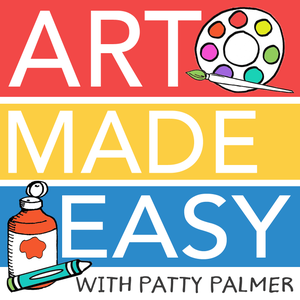 Art Made Easy
Art Made Easy
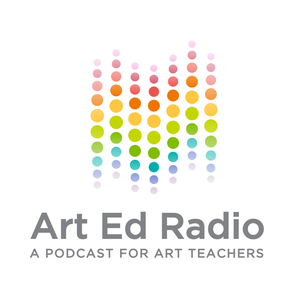 Art Ed Radio
Art Ed Radio
 How She Creates Podcast
How She Creates Podcast
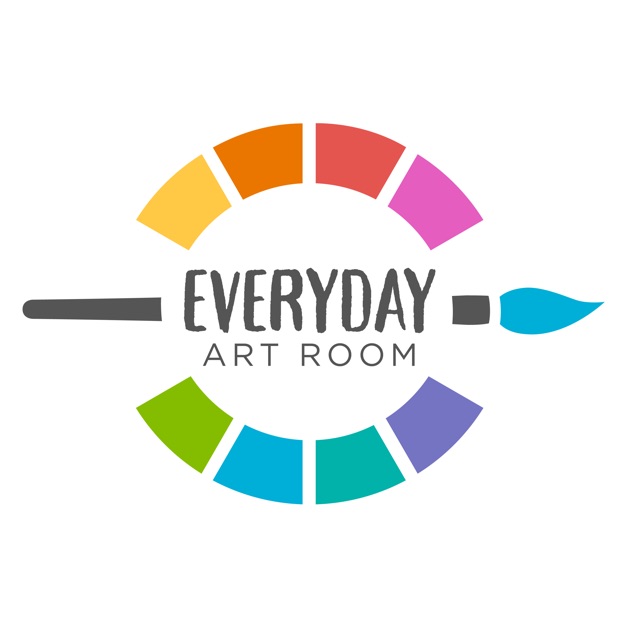 Everyday Art Room
Everyday Art Room
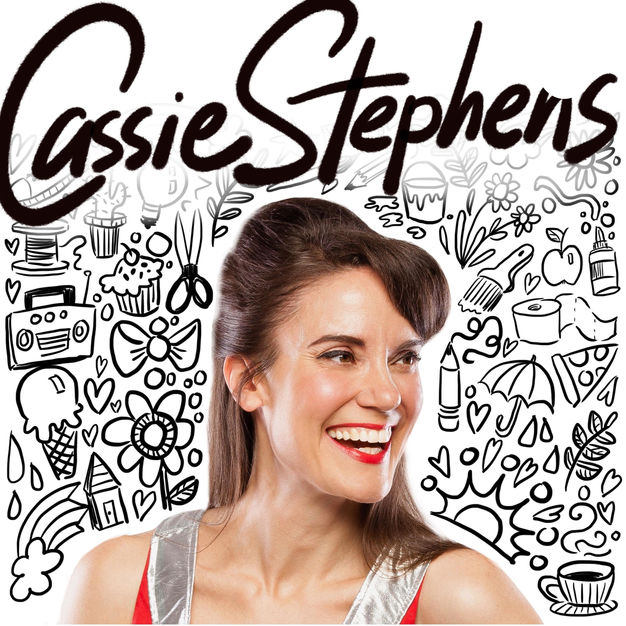 Cassie Stephens
Cassie Stephens
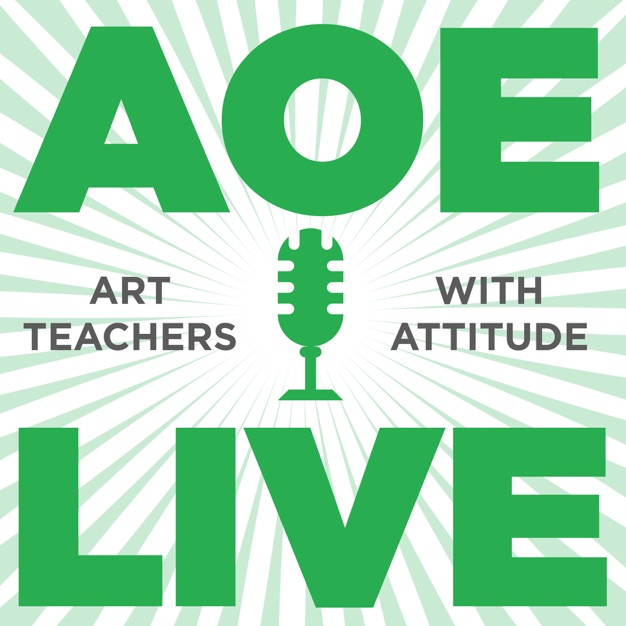 AOE LIVE
AOE LIVE